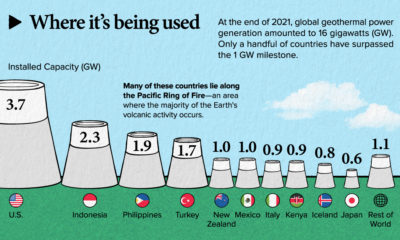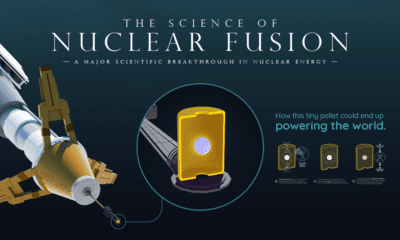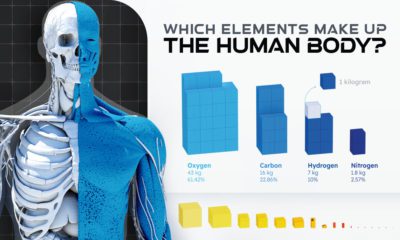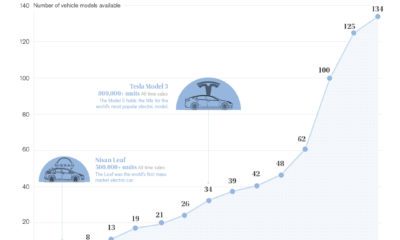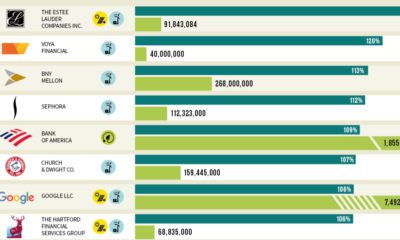The explosive power of hydrogen fueled a chain reaction that led to the world we have today. Now this power is being deployed on Earth to supply the energy needs of tomorrow.
Visualizing the Power of Hydrogen
Today’s infographic comes to us from the Canadian Hydrogen and Fuel Cell Association, and it outlines how hydrogen and fuel cell technology is harnessing the power of the universe to potentially fuel an energy revolution.
What is Hydrogen, and How’s it Used?
With one proton and one electron, hydrogen sits at the very beginning of the periodic table.
Despite hydrogen being the most common molecule in the universe, it is rarely found in its elemental state here on Earth. In fact, almost all hydrogen on the planet is bonded to other elements and can only be released via chemical processes such as steam reforming or electrolysis.
There are five ways hydrogen is being used today:
However, what really unleashes the power of hydrogen is fuel cell technology. A fuel cell converts the chemical power of hydrogen into electrical power.
Hydrogen Unleashed: The Fuel Cell
In the early 1960’s, NASA first deployed fuel cells to power the electrical components of the Gemini and Apollo space capsules. Since then, this technology has been deployed in everything from the vehicle you drive, the train you take, and how your favorite products are delivered to your doorstep.
Nations around the world are committing to build hydrogen fueling stations to meet the growth in adoption of fuel cell technology for transportation.
Hydrogen: A Green Energy Solution
Hydrogen fuel and fuel cell technology delivers green solutions in seven ways. According to a recent report by McKinsey, hydrogen and fuel cell technology has the potential to remove six gigatons of carbon dioxide emissions and employ more than 30 million people by 2050, all while creating a $2.5-trillion market. This is technology that can be deployed today, with the potential to transform how we live and power our economies in a sustainable way. on
#1: High Reliability
Nuclear power plants run 24/7 and are the most reliable source of sustainable energy. Nuclear electricity generation remains steady around the clock throughout the day, week, and year. Meanwhile, daily solar generation peaks in the afternoon when electricity demand is usually lower, and wind generation depends on wind speeds.As the use of variable solar and wind power increases globally, nuclear offers a stable and reliable backbone for a clean electricity grid.
#2: Clean Electricity
Nuclear reactors use fission to generate electricity without any greenhouse gas (GHG) emissions.Consequently, nuclear power is the cleanest energy source on a lifecycle basis, measured in CO2-equivalent emissions per gigawatt-hour (GWh) of electricity produced by a power plant over its lifetime. The lifecycle emissions from a typical nuclear power plant are 273 times lower than coal and 163 times lower than natural gas. Furthermore, nuclear is relatively less resource-intensive, allowing for lower supply chain emissions than wind and solar plants.
#3: Stable Affordability
Although nuclear plants can be expensive to build, they are cost-competitive in the long run. Most nuclear plants have an initial lifetime of around 40 years, after which they can continue operating with approved lifetime extensions. Nuclear plants with lifetime extensions are the cheapest sources of electricity in the United States, and 88 of the country’s 92 reactors have received approvals for 20-year extensions. Additionally, according to the World Nuclear Association, nuclear plants are relatively less susceptible to fuel price volatility than natural gas plants, allowing for stable costs of electricity generation.
#4: Energy Efficiency
Nuclear’s high energy return on investment (EROI) exemplifies its exceptional efficiency. EROI measures how many units of energy are returned for every unit invested in building and running a power plant, over its lifetime. According to a 2018 study by Weissbach et al., nuclear’s EROI is 75 units, making it the most efficient energy source by some distance, with hydropower ranking second at 35 units.
#5: Sustainable Innovation
New, advanced reactor designs are bypassing many of the difficulties faced by traditional nuclear plants, making nuclear power more accessible.
Small Modular Reactors (SMRs) are much smaller than conventional reactors and are modular—meaning that their components can be transported and assembled in different locations. Microreactors are smaller than SMRs and are designed to provide electricity in remote and small market areas. They can also serve as backup power sources during emergencies.
These reactor designs offer several advantages, including lower initial capital costs, portability, and increased scalability.
A Nuclear-Powered Future
Nuclear power is making a remarkable comeback as countries work to achieve climate goals and ultimately, a state of energy utopia. Besides the 423 reactors in operation worldwide, another 56 reactors are under construction, and at least 69 more are planned for construction. Some nations, like Japan, have also reversed their attitudes toward nuclear power, embracing it as a clean and reliable energy source for the future. CanAlaska is a leading exploration company in the Athabasca Basin, the Earth’s richest uranium depository. Click here to learn more now. In part 3 of the Road to Energy Utopia series, we explore the unique properties of uranium, the fuel that powers nuclear reactors.

